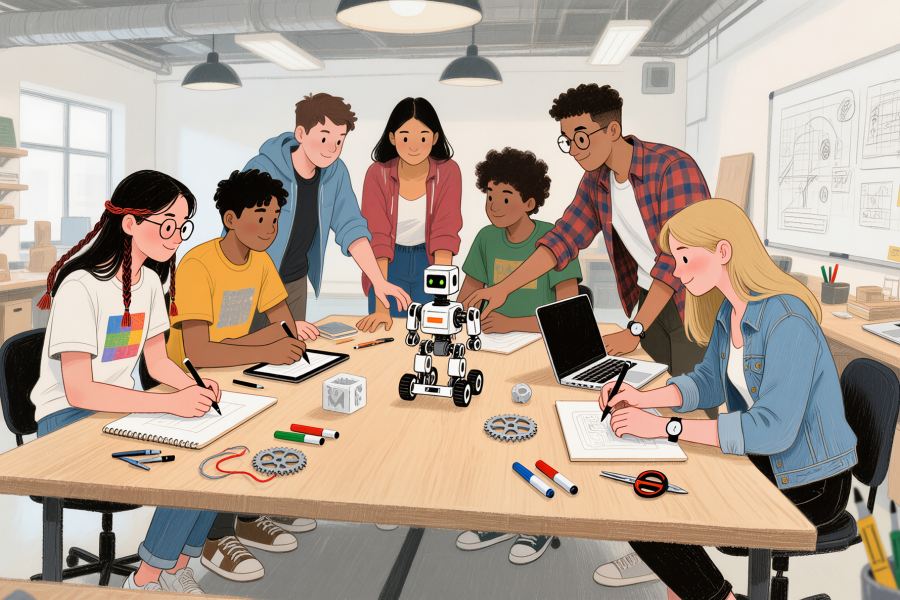Introduction
Have you ever noticed how children light up when they achieve something together—whether it’s finishing a puzzle, playing a sport, or even just tidying up a playroom? That’s teamwork in action. In today’s world, where collaboration is as important as individual talent, teaching children the value of teamwork can make a lasting impact on their growth.
At CMR International School (CMRIS), the Top CBSE School in Suraram, teamwork is seen as more than just a skill—it’s a way of life. Let’s explore how parents, teachers, and schools can encourage teamwork in children, making them not just good learners but also compassionate leaders of tomorrow.
1. Why Teamwork Matters for Children
Teamwork isn’t just about working together—it’s about building life skills. Children who learn to collaborate develop better communication, patience, and leadership qualities. Just like bees in a hive working together to create honey, children too can achieve more when they pool their strengths.
2. The Role of Parents in Nurturing Teamwork
Parents are the first teachers. Encouraging children to share toys, participate in family chores, or even cook a meal together teaches them cooperation. These small practices lay the foundation for bigger teamwork skills later in life.
3. The Role of Teachers and Schools
Schools like CMRIS, the Top CBSE School in Suraram, create structured opportunities for teamwork. Group assignments, cultural events, and science fairs help children work toward a shared goal, learning to appreciate different perspectives.
4. Learning Through Play and Group Activities
Games like building blocks, puzzles, or treasure hunts aren’t just fun—they teach kids how to communicate, wait for their turn, and trust their peers. Play becomes a natural way of learning teamwork without making it feel like a lesson.
5. Sports as a Foundation for Team Spirit
There’s no better teacher of teamwork than sports. Whether it’s cricket, football, or basketball, children learn to rely on each other’s strengths. Winning and losing together also teaches resilience and humility.
6. Classroom Projects That Foster Collaboration
Group projects such as creating models, writing stories, or organizing exhibitions foster creativity and collaboration. Children learn how to divide tasks, support each other, and produce results that are bigger than what they could do alone.
7. The Power of Storytelling and Role-Playing
Stories and role-play exercises encourage children to step into others’ shoes. This builds empathy and helps them understand the importance of working as a team, just like characters in their favorite tales.
8. Encouraging Respect and Listening Skills
Teamwork thrives when children respect each other’s voices. Teaching them to listen actively and value opinions—whether in the classroom or at home—strengthens their ability to collaborate effectively.
9. Problem-Solving Together
When faced with challenges, children can be encouraged to brainstorm solutions as a group. This not only sharpens their critical thinking but also teaches them that solutions are stronger when created together.
10. Building Empathy Through Teamwork
Teamwork allows children to see the struggles and strengths of others. By working together, they learn to support friends who might be weaker in certain areas and appreciate the talents of those who excel.
11. Handling Conflicts Constructively
Conflicts are natural in group settings. Teaching children how to express disagreements respectfully and find common ground helps them develop maturity and emotional intelligence.
12. Celebrating Group Achievements
Recognition matters. Whether it’s a class project, a school play, or a sports event, celebrating group achievements instills pride and motivates children to continue working as a team.
13. How Technology Can Support Team Learning
Digital platforms can be powerful tools for collaboration. Group assignments, virtual projects, and shared learning apps allow children to work together beyond classroom walls, preparing them for future workplaces.
14. CMRIS Approach: A Model for Teamwork Development
At CMR International School, Suraram, teamwork is integrated into academics, sports, and extracurricular activities. Teachers guide students to collaborate, resolve conflicts, and celebrate successes together, making CMRIS a nurturing ground for well-rounded individuals.
15. Conclusion: Preparing Children for Tomorrow
Teamwork isn’t just about school life—it’s a life skill. By fostering cooperation at home and in schools like CMRIS, the Top CBSE School in Suraram, we prepare children to face future challenges with confidence and compassion. After all, in a world that thrives on connection, no child should feel they have to go it alone.
FAQs
1. Why is teamwork important for children?
Teamwork helps children develop communication, empathy, and leadership skills that are essential in school and life.
2. How can parents encourage teamwork at home?
Parents can involve children in shared chores, family games, and group decision-making to instill teamwork.
3. What role do schools play in building teamwork skills?
Schools provide structured group activities, projects, and sports that teach children how to collaborate and respect others.
4. How does teamwork help in academics?
Teamwork enhances problem-solving, boosts creativity, and helps children learn from each other’s strengths.
5. Why is CMRIS considered a model for teamwork?
As the Top CBSE School in Suraram, CMRIS combines academics, sports, and co-curricular activities to ensure children grow as cooperative and confident individuals.



